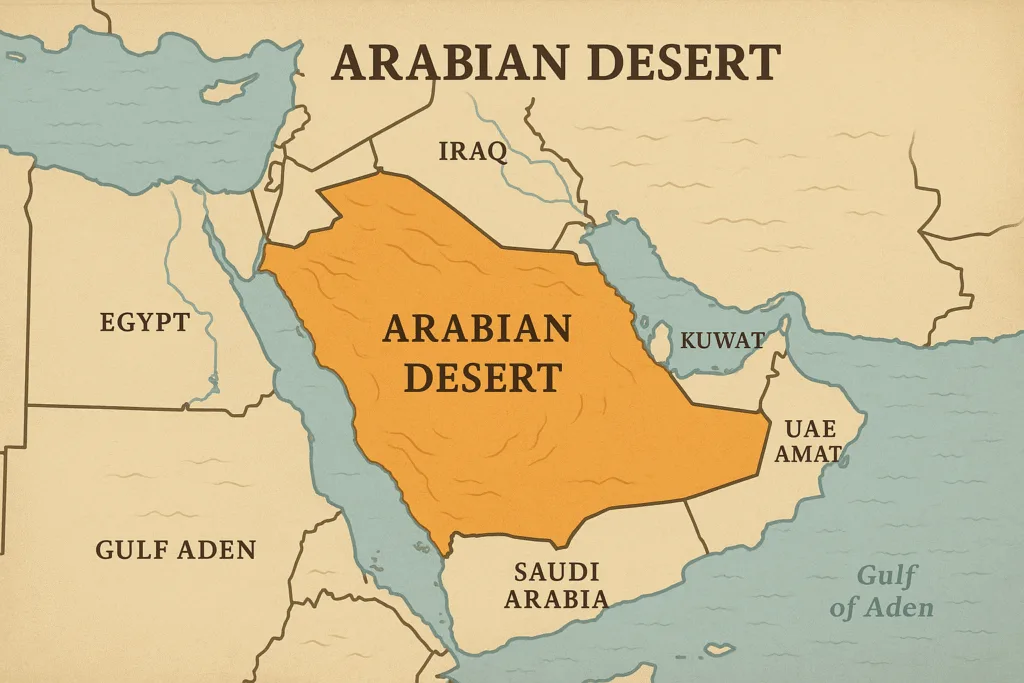Location & Continent
Continent: Asia
Country: India & Pakistan (primarily Rajasthan in India; stretching into Sindh and Punjab in Pakistan)
Coordinates: 27.0000°N, 71.0000°E
Thar Desert – Map & Street View
Physical Features
Area: ~200,000 km² (including Indian and Pakistani sectors)
Length: ~800 km (NE–SW extent)
Width: ~300–500 km (widest across central Rajasthan)
Elevation: Mostly 200–400 m; dune crests commonly 30–100 m above interdunal plains
Climate & Precipitation
Temperature: Intense, dry summers with daytime highs often 42–48 °C; winters are sunny with cool nights (down to 5–10 °C, occasionally lower).
Precipitation: Low and highly variable (~100–300 mm/year on average), delivered mainly by the southwest monsoon (June–September); long dry spells are common outside the monsoon.
Ecological Features
Ecozone: Indomalayan
Biome: Deserts & Xeric Shrublands
Ecoregion: Thar Desert (WWF IM1301)
Flora & Fauna
Flora: Drought-hardy trees and shrubs such as khejri (Prosopis cineraria), acacia (Acacia senegal, Vachellia nilotica), phog (Calligonum polygonoides), lala (Haloxylon salicornicum), caper (Capparis decidua), milkweed (Calotropis procera), and bunchgrasses (Cenchrus spp.) stabilizing dunes.
Fauna: Indian gazelle (chinkara), blackbuck, desert fox (Vulpes vulpes pusilla) and Bengal fox, caracal (localized), desert cat (rare), nilgai near scrub belts; reptiles include spiny-tailed lizard (Saara hardwickii), desert monitor, sand boa; notable birds include the critically endangered Great Indian Bustard, demoiselle cranes (winter), larks, wheatears, and raptors.
Geology & Notable Features
Geology: Quaternary aeolian sands over ancient alluvium, forming ergs (dune seas), stabilized dunes, and interdunal clay pans; wind-sculpted barchans and linear ridges migrate slowly under strong pre-monsoon winds.
Notable Features: Sam Sand Dunes and Khuri near Jaisalmer; Desert National Park (key stronghold of the Great Indian Bustard); Jaisalmer Fort and historic havelis; Gadsisar Lake; Longewala war memorial; vast wind-energy corridors and traditional pastoral landscapes.
Introduction to the Thar Desert
The Thar Desert, also known as the Great Indian Desert, sprawls across northwestern India and eastern Pakistan. Covering approximately 200,000 square kilometers, it stands as one of the largest deserts in the world. This desert is renowned for its stark beauty, unique ecosystems, and rich cultural heritage.
Geography and Climate
The geography of the Thar Desert is defined by its vast sandy expanses and rolling dunes. Characterized by a mix of rocky terrain and dry river beds, the desert is home to a variety of flora and fauna that have adapted to its harsh conditions. The climate is classified as arid, with annual rainfall averaging less than 250 mm, primarily occurring during the monsoon season.
Temperature Variations
The temperature in the Thar Desert can be extreme, ranging from scorching 50°C (122°F) in the summer to chilly 0°C (32°F) during winter nights. This pronounced temperature difference significantly impacts the local biodiversity and human activities.
Flora and Fauna
The Thar Desert supports a surprising variety of life. Despite its arid conditions, it is home to over 700 species of plants and numerous animals. The vegetation includes drought-resistant species like cactuses, acacia, and various grasses.
Wildlife
The wildlife of the Thar is equally diverse. Notable species include the Indian gazelle, desert fox, and blackbuck. In addition, migratory birds flock here during certain seasons, enriching the biodiversity of the region.
Cultural Significance
The Thar Desert is not only a natural landscape but also a tapestry of human life and culture. The vibrant communities living here possess a rich tradition of music, dance, and art. Festivals such as the Pushkar Camel Fair showcase local customs and attract tourists from around the globe.
Economic Activities
The economy of the Thar Desert largely revolves around agriculture, livestock rearing, and handicrafts. The residents cultivate resilient crops like millets and barley and raise livestock, particularly camels, goats, and sheep. Moreover, local artisans are known for their exquisite textiles, leather goods, and pottery.
Comparison with Other Deserts
To understand the Thar Desert’s unique characteristics, a comparison with other major deserts can be insightful. The table below highlights key attributes of the Thar Desert alongside the Sahara and Mojave deserts.
| Desert Name | Area (sq km) | Climate Type | Rainfall (mm/year) |
|---|---|---|---|
| Thar Desert | 200,000 | Arid | 250 |
| Sahara Desert | 9,200,000 | Subtropical | 100 |
| Mojave Desert | 124,000 | Cold desert | 150 |
Conclusion
The Thar Desert is a remarkable ecosystem that showcases the resilience of life in harsh conditions. Its unique geographical features, diverse wildlife, and rich culture contribute significantly to the identity of the region. Visitors to the Thar Desert can expect to experience a blend of natural beauty and human creativity that is unmatched.
References
Thar Desert – Wikipedia
WWF – Thar Desert Ecoregion (IM1301)
Desert National Park – Official Information
Jaisalmer Climate Averages – timeanddate.com
ScienceDirect – Thar Desert overview
FAQ
Where exactly is the Thar Desert?
It spans northwestern India (chiefly Rajasthan, also parts of Gujarat, Haryana, and Punjab) and southeastern Pakistan (Sindh and Punjab), west of the Aravalli Range and east of the Indus floodplains.
When is the best time to visit?
From November to March: warm days, clear skies, and cool nights. April–June is extremely hot; July–September brings the short, dramatic monsoon.
Do I need a 4×4 to explore the dunes?
Paved roads connect major towns, but dune tracks are sandy and change with winds. High-clearance 4×4 with a local driver/guide is strongly recommended for off-road areas like Sam and Khuri.
Is there wildlife to see?
Yes. With patience and local guidance, you can spot chinkara, desert foxes, spiny-tailed lizards, and notable birds such as the Great Indian Bustard and demoiselle cranes in winter.
What are the highlights for first-time visitors?
Sunset over the Sam Sand Dunes, the golden ramparts of Jaisalmer Fort, star-filled skies in Desert National Park, and cultural experiences with desert music and camel safaris.
Can I camp or stargaze?
Absolutely—choose established camps or durable ground, respect protected zones, carry sufficient water, and prepare for cold night temperatures even in peak season.


